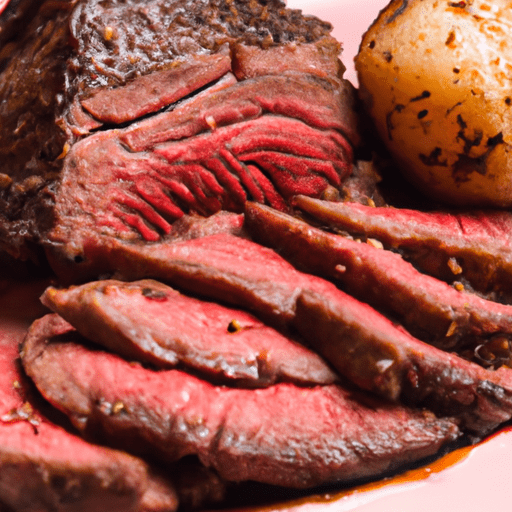The Versatile and Flavorful Chuck Roast: A Chef’s Secret Weapon
Chuck roast, also known as chuck steak or blade roast, is a cut of beef that is treasured by chefs and home cooks alike for its rich flavors and versatility in the kitchen. Derived from the shoulder area of a cow, chuck roast offers a delightful combination of tenderness, juiciness, and deep beefy taste that makes it a true culinary gem. Whether you slow-cook it until it falls apart or sear it to perfection, this cut never fails to impress.
A Flavorful Journey on the Palate
Chuck roast boasts a robust and beef-forward flavor that makes it a favorite for hearty and comforting dishes. The marbling of fat within the meat creates a melt-in-your-mouth tenderness while adding an abundance of flavor. When properly cooked, the meat becomes incredibly juicy, ensuring each bite is a succulent delight.
Cooking with Chuck Roast
The versatility of chuck roast shines through its wide range of cooking techniques. Here are a few popular methods for expertly preparing this cut:
1. Slow cooking: Chuck roast is an ideal candidate for slow cooking methods such as braising or pot-roasting. By allowing the meat to cook low and slow, it becomes tender and moist, easily falling apart. Whether you’re making a classic pot roast with root vegetables or a spicy beef stew, chuck roast will infuse your dish with unparalleled richness.
2. Smoking or barbecuing: Chuck roast’s deep beefy flavor pairs exceptionally well with smoky nuances. Slow-smoking or barbecuing chuck roast lends it a tantalizingly smoky flavor and a delectably caramelized crust. The result is a dish that will make your taste buds dance with joy. Perfect for pulled beef sandwiches or as the centerpiece of a backyard barbecue feast.
3. Pan-searing: Contrary to popular belief, chuck roast can also excel when pan-seared to achieve a beautiful crust while retaining its juicy interior. Sear it on high heat for a few minutes on each side, then finish it in the oven for a perfectly medium-rare result. Slice it thin, and you’ll be rewarded with a tender and delectable steak-like experience.
Nutritional Value of Chuck Roast
Chuck roast is not only a flavor powerhouse but also a nutrient-rich food choice. Rich in protein, iron, and zinc, chuck roast contributes to muscle growth, provides energy, and strengthens the immune system. However, it is worth noting that chuck roast contains a higher fat content compared to leaner cuts of beef. Moderation is key when incorporating it into a balanced diet.
A Brief History
The chuck roast has a historical significance tied to the development of cattle ranching in North America. In the early days, the chuck, or shoulder, was deemed a less desirable cut. It wasn’t until the rise of industrial meatpacking in the late 19th century that chuck roast gained popularity. With innovative packaging and refrigeration techniques, this cut became more accessible and affordable to a wider audience.
Final Thoughts
Chuck roast continues to bring joy to kitchens across the world with its incredible taste and versatility. Whether you braise it, smoke it, or sear it, this cut’s beefy and melt-in-your-mouth qualities make it a favorite for both casual family dinners and celebratory feasts. So, the next time you find yourself craving a dish that oozes warmth and comfort, embrace the chuck roast and let its magic unfold on your plate.
Chuck Roast
Origin: Chuck roast, also known as chuck steak or pot roast, comes from the shoulder section of the cow. The term “chuck” refers to the cut’s location, which is from the neck down to the fifth rib. It is a popular cut of beef in the United States.
Common Uses: Chuck roast is commonly used for slow cooking methods like braising, roasting, and stewing. It’s well-suited for these methods because it is a tougher cut of meat, with a good amount of connective tissue. Slow cooking helps break down the collagen, resulting in a tender and flavorful roast.
Nutritional Benefits: Chuck roast is a rich source of protein, vitamins, and minerals. It is particularly high in vitamin B12, zinc, iron, and selenium. However, it is also higher in fat content compared to leaner cuts of beef, so moderation is key when incorporating it into a balanced diet.
Unique Properties: Chuck roast contains a good amount of marbling, which is the intramuscular fat that adds flavor and juiciness to the meat when cooked. This marbling is what contributes to the intense beefy flavor of chuck roast. Additionally, the connective tissues in chuck roast, like collagen, provide gelatin when cooked slowly, making the meat tender and succulent.
Historical Significance: In the past, chuck roast was considered to be a cheaper and less desirable cut of meat, often used for stews and pot roasts due to its toughness. However, as culinary trends have shifted, slow-cooked dishes have gained popularity, and chuck roast has become a sought-after cut for its flavor and versatility. It has become a staple in many traditional American recipes, such as pot roast and beef stew.
Remember that chuck roast should always be cooked to a safe internal temperature to ensure proper food safety.




Use the share button below if you liked it.
It makes me smile, when I see it.